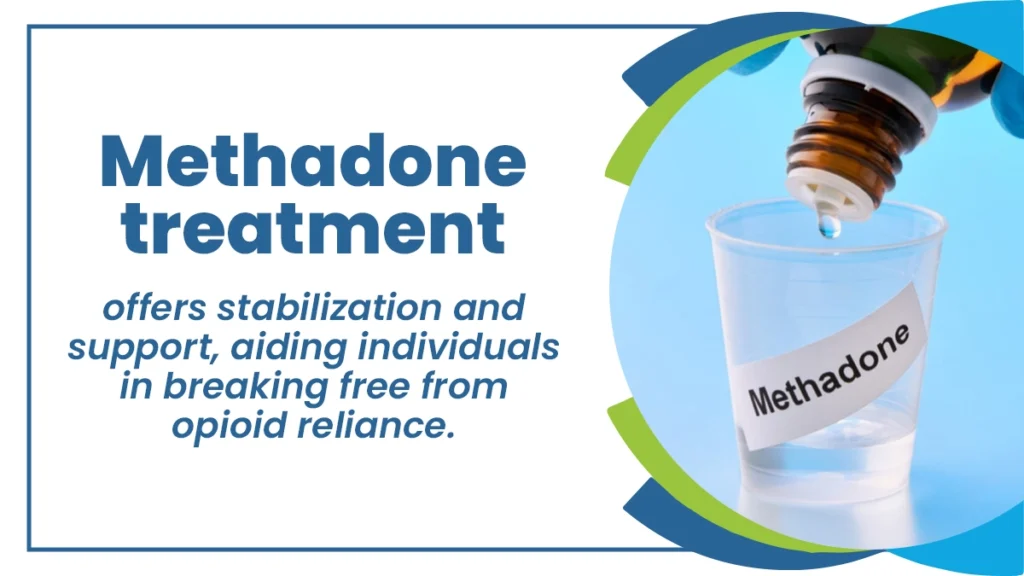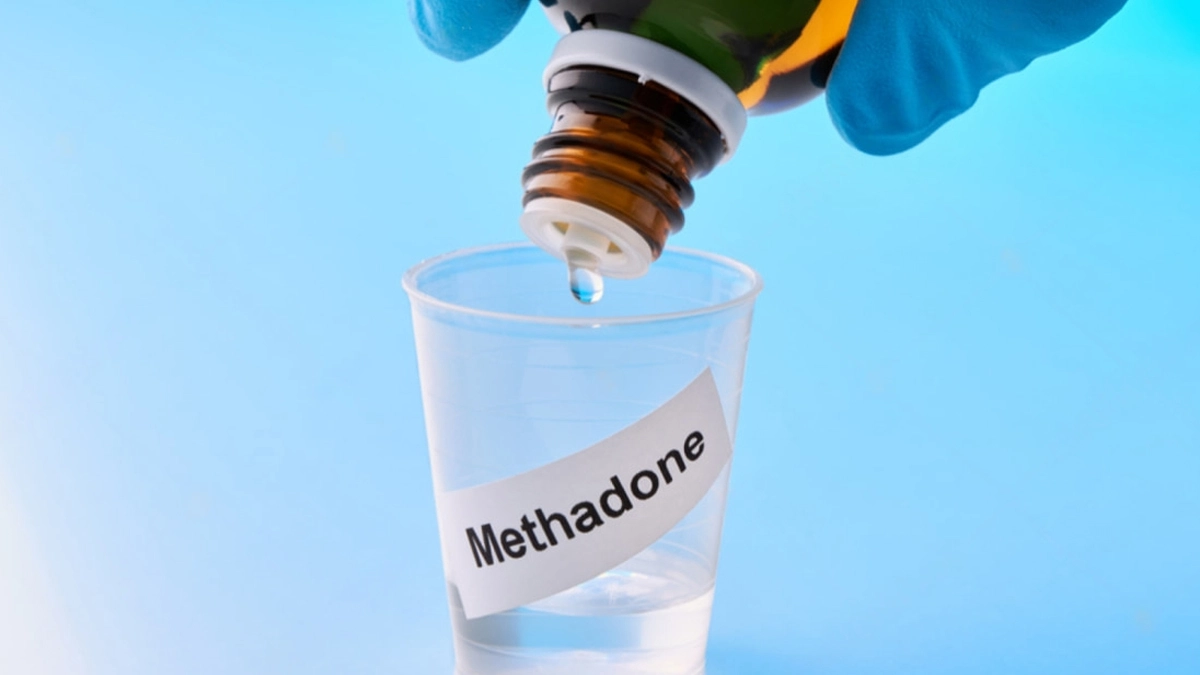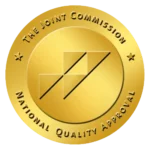Methadone, a synthetic opioid agonist, is used in the treatment of opioid use disorder (OUD) and chronic pain. It functions by attaching to the same receptors in the brain as other opioid drugs, such as heroin or prescription painkillers.
Essentially, it mimics the action of these drugs without producing the same high or adverse side effects. This helps individuals manage cravings and withdrawal symptoms without experiencing the extreme ups and downs of opioid use.
Key Takeaways
Methadone is a prescription medication crucial for severe pain management and treating opioid use disorder (OUD). Here is what this article covers:
- Developed initially as a pain relief medication, methadone evolved into a treatment for opioid addiction.
- Methadone interacts with brain receptors, easing opioid withdrawal symptoms and cravings without the intense high.
- Methadone treatment offers stabilization and support, aiding individuals in breaking free from opioid reliance.
- Careful medication dosage adjustments and adherence to administration guidelines ensure safe and effective treatment.
- Methadone can cause short- and long-term effects and poses overdose risks if misused or combined with other substances.
Reach out to The Haven Detox-Little Rock at (501) 271-3342 for compassionate support on your journey to substance abuse recovery.
Introduction to Methadone
Methadone, a synthetic opioid medication, serves a crucial purpose in managing opioid addiction. It’s designed to help individuals gradually reduce their dependence on potent opioids like heroin or prescription painkillers. By binding to the brain’s opioid receptors, methadone minimizes the discomfort of withdrawal and curbs the intense urge to use opioids.
The history of methadone dates back to the mid-20th century when it was developed as a pain reliever. However, Its use expanded to treat opioid dependence due to its unique properties. In the 1960s, methadone maintenance programs (MMTs) began emerging as a way to support individuals struggling with opioid dependency.
Since then, it has become a cornerstone of medication-assisted treatment programs, playing a crucial role in helping countless individuals regain control over their lives amid opioid addiction. Methadone’s journey from pain medication to a vital tool in addiction treatment showcases its evolution and impact on healthcare.
How Methadone Works
In opioid addiction treatment, methadone stands as one of the key players, but how does it actually work? To understand how it works, we delve into the biology of methadone, exploring its neurological impact and molecular interactions.
The Biology of Methadone
When ingested, methadone enters the bloodstream and travels to the brain, where it binds to opioid receptors. By attaching to these receptors, methadone blocks the effects of other opioids while still activating them to a lesser degree. This action helps to reduce drug cravings and withdrawal symptoms, allowing individuals to regain stability without experiencing the extreme highs and lows associated with opioid use.
The Neurological Impact of Methadone
Neurologically, methadone alters the way the brain processes pain and pleasure signals. It modulates neurotransmitters like dopamine, associated with pleasure, reward, and motivation. By maintaining a stable level of neurotransmitter activity, methadone assists in curbing the intense cravings and emotional fluctuations experienced during opioid withdrawal.
Methadone and Molecular Interactions
At a molecular level, methadone’s structure allows it to bind to the same receptors that opioids target. Its unique chemical composition and longer duration of action compared to shorter-acting opioids make it an effective tool in managing addiction. These molecular interactions contribute to its role in providing a smoother and more controlled transition for opioid-dependent patients.

Managing Opioid Dependency: The Role of Methadone
Opioid dependence is a serious health concern affecting many across the United States. Fortunately, methadone has emerged as a valuable treatment option, offering a path toward recovery. Here, we will explore how methadone serves as a crucial tool in addressing opioid dependence.
Methadone as a Treatment for Opioid Dependence
Methadone plays a pivotal role in addressing opioid dependence, offering a structured pathway toward recovery. It’s prescribed as part of a comprehensive treatment plan aimed at reducing the reliance on more potent opioids like heroin or prescription pain medications.
Unlike those substances, methadone eases withdrawal symptoms without causing the intense high, enabling individuals to function as usual while focusing on their recovery.
Transitioning to Methadone
Transitioning to methadone involves a thoughtful process led by healthcare professionals. Initially, a comprehensive assessment determines the appropriate dosage needed based on the individual’s opioid usage and withdrawal symptoms. This assessment ensures a tailored approach to address each person’s unique needs.
Once the dosage is determined, individuals begin taking methadone orally, usually in a liquid form. Regular follow-ups with healthcare providers monitor progress and adjust the dosage if necessary to ensure effectiveness and safety.
Methadone Maintenance Treatment (MMT)
Methadone maintenance treatment (MMT) involves the long-term use of methadone as part of a comprehensive recovery program. This treatment approach helps individuals stabilize their lives, reducing the disruptive impact of opioid addiction.
MMT isn’t just about medication; it encompasses counseling, behavioral therapies, and access to support services, fostering a holistic approach to recovery. By participating in MMT, individuals have the opportunity to rebuild their lives, regain control, and gradually work towards independence from opioids.
Managing Methadone: Dosing and Administration
Ensuring the safe and effective use of methadone requires a careful understanding of dosage determination and administration guidelines. Let’s explore how the dosage is determined and the guidelines for its administration.
Determining The Appropriate Dosage
Determining the right dose of methadone for an individual undergoing treatment involves a careful assessment by healthcare professionals. Factors such as the severity of addiction, tolerance levels, and overall health are taken into account.
Typically, when starting methadone treatment, a low initial dosage is administered, gradually increasing until the proper balance between managing withdrawal symptoms and avoiding side effects is achieved. Regular assessments help ensure the dosage remains effective and safe.
Guidelines for Administration
Methadone is typically administered orally, either as a liquid form or a dissolvable tablet. The choice between these forms depends on individual preferences and circumstances. The dosage is taken in a controlled setting, such as a methadone clinic or a treatment center, to ensure accuracy and safety.
Initially, individuals may need to visit the clinic daily for their dose. But as progress is made and stability is achieved, some may qualify for take-home doses, reducing the frequency of clinic visits. Adherence to the prescribed dosage is crucial to the success of the treatment, as deviations can lead to withdrawal symptoms or opioid cravings.
The Darker Side: Risks of Methadone Use
Methadone, while a valuable tool in treating opioid dependence, is not without potential side effects and health risks. Understanding these aspects is crucial for individuals undergoing treatment to ensure a balanced and safe recovery journey.
Potential Short-term Effects
Methadone can also bring about certain short-term effects, such as drowsiness, constipation, nausea, sweating, and runny nose. These effects of methadone are often temporary and tend to decrease as the body adjusts to the medication. It’s essential for individuals undergoing methadone treatment to communicate any discomfort or side effects to their healthcare provider to ensure proper management.
Potential Long-term Effects
Using methadone for a longer period of time might lead to specific effects, although these vary from person to person. Some individuals may experience changes in hormone levels, which can affect aspects like sexual function or menstruation. Weight changes and dental issues have also been reported in some cases. Regular check-ups and open communication with doctors are crucial to effectively address and manage any emerging long-term effects.
Risks of Overdose on Methadone
One of the significant risks associated with methadone is the potential for overdose, especially when taken in larger quantities than prescribed or when combined with other substances like alcohol or sedatives. Methadone overdose can lead to breathing problems or even respiratory failure, which can be life-threatening. It’s crucial to strictly adhere to the prescribed dosage and avoid mixing methadone with other substances to mitigate the risk of overdose.
Frequently Asked Questions (FAQ)
Why is methadone so regulated?
Methadone is tightly regulated due to its potential for misuse and overdose. The strict controls ensure safe administration, minimizing risks and preventing unauthorized access. These regulations help monitor dosage, prevent drug abuse, and safeguard individuals undergoing opioid treatment programs. Such measures aim to strike a balance, ensuring methadone’s benefits in treating opioid dependence while reducing associated dangers.
How does methadone function in the body to treat opioid addiction?
Methadone helps treat opiate addiction by interacting with the brain’s opioid receptors, reducing withdrawal symptoms and cravings. Unlike stronger opioids, it doesn’t produce a euphoric high but stabilizes the brain’s chemistry. This gradual, controlled effect enables individuals to manage their addiction, break free from the cycle of intense cravings, and focus on long-term recovery. The process is carefully monitored by healthcare professionals to ensure safe and effective treatment.
What does it feel like to take methadone?
Taking methadone doesn’t make you feel high like some other opioids. Instead, it provides a steady and subtle effect. It helps manage withdrawal symptoms and cravings without causing sedation. People might feel more balanced and able to focus, contributing to a sense of stability. It’s important to follow the prescribed dosage to ensure a safe and effective experience with methadone.
How do I make my methadone more effective?
To maximize the effectiveness of methadone, follow the prescribed dosage carefully. Communicate openly with doctors about any concerns or changes in how you feel. Stick to the treatment plan, attend appointments regularly, and participate in counseling or support programs. Avoid the use of alcohol or benzodiazepines without consulting your healthcare provider, as they can affect methadone’s effectiveness.
The Haven Detox-Little Rock: A Safe Passage to Recovery
Struggling with methadone addiction can feel overwhelming, but you’re not alone. The Haven Detox-Little Rock understands the challenges and is here to guide you toward freedom. Our programs help you break free from the grip of addiction.
Begin with our medical detox—let us guide your body through the adjustment without relying on drugs, easing both physical and mental withdrawal symptoms.
After detox, step into our residential treatment program to get 24/7 care under medical supervision. You’ll receive top-notch support, therapy, and the highest quality care, paving the way for a smooth transition into a renewed life filled with possibilities.Reach out to us at (501) 271-3342 today to start your journey toward a healthier, more fulfilling life. Don’t wait—your path to recovery begins with a phone call.





